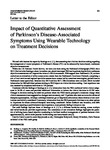Impact of Quantitative Assessment of Parkinson’s Disease-Associated Symptoms Using Wearable Technology on Treatment Decisions
| dc.contributor.author | Carroll, Camille | |
| dc.contributor.author | Kobylecki, C | |
| dc.contributor.author | Silverdale, M | |
| dc.contributor.author | Thomas, C | |
| dc.date.accessioned | 2019-09-02T13:59:40Z | |
| dc.date.available | 2019-09-02T13:59:40Z | |
| dc.date.issued | 2019-07-30 | |
| dc.identifier.issn | 1877-7171 | |
| dc.identifier.issn | 1877-718X | |
| dc.identifier.uri | http://hdl.handle.net/10026.1/14858 | |
| dc.description.abstract |
We read with interest the report by Santiago et al. [1], demonstrating that clinician decision making regarding the management of motor symptoms of Parkinson’s disease (PD) can be enhanced by home-based, continuous objective measurement. Within the UK National Health Service, we have also been using the Parkinson’s Kinetigraph (PKG) since 2015. Similar to the Santiago cohort, in routine care, physicians target PKG use in patients they believe continuous objective measurement will improve the value of clinical encounters. With support from Parkinson’s UK, we have carried out an evaluation of utility across seven centers from the Parkinson’s Excellence Network, comprising a mix of local services and regional specialist neuroscience centers led by consultant neurologists, geriatricians or Parkinson’s nurse specialists. | |
| dc.format.extent | 601-601 | |
| dc.format.medium | ||
| dc.language | eng | |
| dc.language.iso | eng | |
| dc.publisher | IOS Press | |
| dc.subject | Drug Delivery Systems | |
| dc.subject | Humans | |
| dc.subject | Movement | |
| dc.subject | Parkinson Disease | |
| dc.subject | Wearable Electronic Devices | |
| dc.title | Impact of Quantitative Assessment of Parkinson’s Disease-Associated Symptoms Using Wearable Technology on Treatment Decisions | |
| dc.type | journal-article | |
| dc.type | Journal Article | |
| dc.type | Comment | |
| plymouth.author-url | https://www.webofscience.com/api/gateway?GWVersion=2&SrcApp=PARTNER_APP&SrcAuth=LinksAMR&KeyUT=WOS:000477944000013&DestLinkType=FullRecord&DestApp=ALL_WOS&UsrCustomerID=11bb513d99f797142bcfeffcc58ea008 | |
| plymouth.issue | 3 | |
| plymouth.volume | 9 | |
| plymouth.publication-status | Published | |
| plymouth.journal | Journal of Parkinson's Disease | |
| dc.identifier.doi | 10.3233/jpd-191623 | |
| plymouth.organisational-group | /Plymouth | |
| plymouth.organisational-group | /Plymouth/Faculty of Health | |
| plymouth.organisational-group | /Plymouth/Faculty of Health/Peninsula Medical School | |
| plymouth.organisational-group | /Plymouth/REF 2021 Researchers by UoA | |
| plymouth.organisational-group | /Plymouth/REF 2021 Researchers by UoA/UoA03 Allied Health Professions, Dentistry, Nursing and Pharmacy | |
| plymouth.organisational-group | /Plymouth/Research Groups | |
| plymouth.organisational-group | /Plymouth/Research Groups/FoH - Applied Parkinson's Research | |
| plymouth.organisational-group | /Plymouth/Research Groups/FoH - Community and Primary Care | |
| plymouth.organisational-group | /Plymouth/Research Groups/Institute of Translational and Stratified Medicine (ITSMED) | |
| plymouth.organisational-group | /Plymouth/Research Groups/Institute of Translational and Stratified Medicine (ITSMED)/CCT&PS | |
| plymouth.organisational-group | /Plymouth/Research Groups/Plymouth Institute of Health and Care Research (PIHR) | |
| plymouth.organisational-group | /Plymouth/Users by role | |
| plymouth.organisational-group | /Plymouth/Users by role/Academics | |
| dc.publisher.place | Netherlands | |
| dc.identifier.eissn | 1877-718X | |
| dc.rights.embargoperiod | 2024-01-04 | |
| rioxxterms.versionofrecord | 10.3233/jpd-191623 | |
| rioxxterms.licenseref.uri | http://www.rioxx.net/licenses/all-rights-reserved | |
| rioxxterms.type | Journal Article/Review |


